Characterization of Environmental Education in Spanish Geography Textbooks
Abstract
1. Introduction
1.1. Context and Goal
1.2. State of the Research Field
2. Materials and Methods
2.1. Materials
2.2. Methods
- 0-It is not developed.
- 1-It is scantily developed.
- 2-It is superficially developed.
- 3-It is developed in detail.
- 4-It is fully developed.
- Involves locating and repeating information in the book.
- Involves understanding information in the book, and then summarizing it, paraphrasing it, mapping it, establishing similarities and/or differences, associating concepts, etc.
- Involves analyzing, applying and/or evaluating information in the book, as well as creating new information.
3. Results
3.1. Results by Publisher
3.2. Results by School Grade
4. Discussion
5. Conclusions
5.1. Contribution
5.2. Limitations and Open Issues
Author Contributions
Funding
Institutional Review Board Statement
Informed Consent Statement
Data Availability Statement
Acknowledgments
Conflicts of Interest
Appendix A
- Anaya (An)
- Benítez, J. K., Cano, J. A., Fernández, E. y Marchena, C. (2014). Ciencias Sociales 3. ANAYA. Proyecto Aprender es crecer. Edición Castilla-La Mancha. ISBN: 978-84-678-4800-7.
- Benítez, J. K., Cano, J. A., Fernández, E. y Marchena, C. (2015). Ciencias Sociales 6. ANAYA. Proyecto Aprender es crecer. Edición Castilla-La Mancha. ISBN: 978-84-678-8117-2.
- Burgos, M. y Muñoz-Delgado, M.C. (2015). ESO 3. Geografía e Historia. ANAYA. Proyecto Aprender es crecer en conexión. ISBN: 978-84-678-5233-2.
- Santillana (San)
- Moral, A., Verger, T. y Echevarría, E. (2014). Primaria 3. Ciencias Sociales. Santillana. Proyecto Saber Hacer. ISBN: 978-84-680-1343-5.
- Bellón, A. et al. (2015). Primaria 6. Ciencias Sociales. Santillana. Proyecto Saber Hacer. ISBN: 978-84-680-2942-9. Incluye material complementario: Lo esencial de Ciencias Sociales.
- Abascal, F. et al. (2015). 3 ESO. Geografía e Historia. Santillana. Proyecto Saber Hacer. ISBN: 978-84-680-3367-9.
- SM (SM)
- Pérez, J. L., Gómez, M., Navarro, A. y López, S. (2014). Ciencias Sociales 3 Primaria. SM. Proyecto Savia. Edición Castilla-La Mancha. ISBN: 978-84-675-7000-7. Incluye material complementario: ATLAS. Conozco mi comunidad. Ciencias Sociales. Castilla-La Mancha. 3 primaria. ISBN: 978-84-675-7046-5.
- Martín, S., Parra, E., De la Mata, A., Hidalgo, J. M. y Moratalla, V. (2015). Ciencias Sociales 6 Primaria. SM. Proyecto Savia. Edición Castilla-La Mancha. ISBN: 978-84-675-7568-2. Incluye material complementario: ATLAS. Mi mundo, mi país, mi comunidad. Ciencias Sociales. Castilla-La Mancha. 6 primaria. ISBN: 978-84-675-7577-4.
- Lázaro, M., Tébar, J., Buzo, I. y Araújo, J. (2015). Geografía e Historia 3 ESO. SM. Proyecto Savia. ISBN: 978-84-675-7640-5.
References
- Colín, L. Deterioro ambiental vs. desarrollo económico y social. Boletín IIE 2003. Available online: https://www.ineel.mx/boletin032003/art2.pdf (accessed on 21 January 2021).
- Zelezny, L.C.; Schultz, P.W. Promoting environmentalism. J. Soc. Issues 2000, 56, 365–371. Available online: https://web.stanford.edu/~kcarmel/CC_BehavChange_Course/readings/Additional%20Resources/J%20Soc%20Issues%202000/delivery%253Bid=2gms91ynk0pcr.pdf (accessed on 21 January 2021). [CrossRef]
- Fernández, R. El Antropoceno: La Expansión del Capitalismo Global Choca con la Biosfera; Virus: Barcelona, Spain, 2011. [Google Scholar]
- Waters, C.N.; Zalasiewicz, J.; Summerhayes, C.; Barnosky, A.D.; Poirier, C.; Gałuszka, A.; Jeandel, C. The Anthropocene is functionally and stratigraphically distinct from the Holocene. Science 2016, 351, aad2622. [Google Scholar] [CrossRef]
- Vilches, A.; Pérez, D.G. El Antropoceno como oportunidad para reorientar el comportamiento humano y construir un futuro sostenible. Rev. Electrón. Enseñ. Cienc. 2011, 10, 394–419. Available online: http://reec.uvigo.es/volumenes/volumen10/REEC_10_3_1.pdf (accessed on 21 January 2021).
- Corral-Verdugo, V.; Pinheiro, J.D.Q. Aproximaciones al estudio de la conducta sustentable. Medio Ambiente Y Comport. Hum. 2004, 5, 1–26. Available online: https://mach.webs.ull.es/PDFS/Vol5_1y2/VOL_5_1y2_a.pdf (accessed on 21 January 2021).
- González, A.; Amérigo, M. Actitudes hacia el medio ambiente y conducta ecológica. Psicothema 1999, 11, 13–25. Available online: http://www.psicothema.com/pdf/227.pdf (accessed on 21 January 2021).
- Riechmann, J. Desarrollo sostenible: La lucha por la interpretación. In De la Economía a la Ecología; Trotta: Madrid, Spain, 1995; pp. 1–35. [Google Scholar]
- UN Conference on the Human Environment (Stockholm Conference, 1972). Available online: https://sustainabledevelopment.un.org/milestones/humanenvironment (accessed on 22 November 2020).
- Gutiérrez, J. La educación Ambiental: Fundamentos Teóricos, Propuestas de Transversalidad y Orientaciones Extracurriculares; Editorial La Muralla: Madrid, Spain, 1995. [Google Scholar]
- UN Conference on Environment and Development (Rio de Janeiro, 1992). Available online: https://sustainabledevelopment.un.org/milestones/unced (accessed on 22 November 2020).
- UN Sustainable Development Summit (New York, 2015). Available online: https://sustainabledevelopment.un.org/post2015/summit (accessed on 22 November 2020).
- Poortinga, W.; Steg, L.; Vlek, C. Values, environmental concern, and environmental behavior: A study into household energy use. Environ. Behav. 2004, 36, 70–93. [Google Scholar] [CrossRef]
- Halstead, J.M. Values and Values Education in Schools. In Values in Education and Education in Values; Halstead, J.M., Taylor, M.J., Eds.; The Falmer Press: London, UK, 1996. [Google Scholar]
- Carvalho, G.S.; Tracana, R.B.; Skujiene, G.; Turcinaviciene, J. Trends in environmental education images of textbooks from Western and Eastern European countries and non-European countries. Int. J. Sci. Educ. 2011, 33, 2587–2610. [Google Scholar] [CrossRef]
- Campaner, G.; De Longhi, A.L. La argumentación en Educación Ambiental. Una estrategia didáctica para la escuela media. Rev. Electró. Enseñ. Cienc. 2007, 6, 442–456. Available online: http://reec.uvigo.es/volumenes/volumen6/ART12_Vol6_N2.pdf (accessed on 21 January 2021).
- Velázquez, F. Educación Ambiental: Orientaciones, Actividades, Experiencias y Materiales; Narcea Ediciones: Madrid, Spain, 1995. [Google Scholar]
- Guo, F.; Meadows, M.E.; Duan, Y.; Gao, C. Geography Pre-Service Teachers’ Perspectives on Multimedia Technology and Environmental Education. Sustainability 2020, 12, 6903. [Google Scholar] [CrossRef]
- Martinez-Medina, R.; Arrebola, J.C. Analysis of Sustainability Activities in Spanish Elementary Education Textbooks. Sustainability 2019, 11, 5182. [Google Scholar] [CrossRef]
- Carretero, A.M.H.; Burgui, M.B.; de Castro, F.V.; Vázquez, J.M.C. Responden los libros de texto a las demandas de la educación ambiental. Un análisis para la educación secundaria. Bol. Asoc. Geógr. Esp. 2018, 80–110. [Google Scholar] [CrossRef]
- Pingel, F. UNESCO Guidebook on Textbook Research and Textbook, 2nd ed.; UNESCO: Paris, France, 2010; Available online: http://unesdoc.unesco.org/images/0011/001171/117188e.pdf (accessed on 21 January 2021).
- Pagès, J. Los libros de texto de ciencias sociales, geografía e historia y el desarrollo de las competencias ciudadanas. In Textos Escolares de Historia y Ciencias Sociales, Seminario Internacional; Ministerio de Educación de Chile: Santiago, Chile, 2008; pp. 24–56. [Google Scholar]
- Prats, J. Criterios para la elección del libro de texto de historia. Íber Didáctica Cienc. Soc. Geogr. Hist. 2012, 18, 7–13. [Google Scholar]
- Gómez, C.J.; Cózar, R.; Miralles, P. La enseñanza de la historia y el análisis de libros de texto. Construcción de identidades y desarrollo de competencias. Ens. Rev. Fac. Educ. Albacete 2014, 29, 11–25. Available online: https://www.um.es/dicso/es/wp-content/uploads/Ense%C3%B1_hist_lib_texto1.pdf (accessed on 21 January 2021).
- Gómez, C.J.; Molina, S.; Pagán, B. Los manuales de Ciencias Sociales y la enseñanza de la Historia del Arte en 2° de ESO. Ens. Rev. Fac. Educ. Albacete 2012, 27, 69–88. [Google Scholar]
- Apple, M. Official Knowledge: Democratic Education in a Conservative Age; Routledge: New York, NY, USA, 1993. [Google Scholar]
- Martínez, N.; Valls, R.; Pineda, F. El uso del libro de texto de Historia de España en Bachillerato: Diez años de estudio, 1993–2003 y dos reformas (LGE-LOGSE). Didáct. Cienc. Exp. Soc. 2009, 23, 3–35. Available online: https://roderic.uv.es/handle/10550/21099 (accessed on 21 January 2021).
- Güemes, R. Libros de Texto y Desarrollo del Currículo en el Aula: Un Estudio de Casos; Universidad de La Laguna: La Laguna, Spain, 1994. [Google Scholar]
- Raja, M.J.; Miralles, P. La enseñanza de la Geografía física en los libros de texto de educación secundaria: De la Ley General de Educación a la Ley Orgánica de Educación. Didáct. Geogr. 2014, 15, 109–128. Available online: https://didacticageografica.age-geografia.es/index.php/didacticageografica/article/view/269/247 (accessed on 21 January 2021).
- Gómez, C.J.; Ortuño, J.; Molina, S. Aprender a pensar históricamente. Retos para la historia en el siglo XXI. Tempo E Argum. 2014, 6, 5–27. [Google Scholar] [CrossRef]
- Petrus, A. Pedagogía Social; Ariel: Madrid, Spain, 1997. [Google Scholar]
- Lee, J.; Catling, S. Some perceptions of English geography textbook authors on writing textbooks. Int. Res. Geogr. Environ. Educ. 2016, 25, 50–67. [Google Scholar] [CrossRef]
- Hopkin, J. The world according to geography textbooks: Interpretations of the English national curriculum. Int. Res. Geogr. Environ. Educ. 2001, 10, 46–67. [Google Scholar] [CrossRef]
- De-la Peña, G.; Vinces-Centeno, M.R. Acercamiento a la conceptualización de la educación ambiental para el desarrollo sostenible. Rev. Cuba. Educ. Super. 2020, 39. Available online: http://scielo.sld.cu/scielo.php?script=sci_arttext&pid=S0257-43142020000200018&lng=es&tlng=es (accessed on 21 January 2021).
- UNESCO. 2014 Aichi-Nagoya Declaration on Education for Sustainable Development (ESD). In Proceedings of the World Conference, Aichi-Nagoya, Japan, 10–12 November 2014; Available online: https://unesdoc.unesco.org/ark:/48223/pf0000231074 (accessed on 21 January 2021).
- UNESCO. 2018 Issues and Trends in Education for Sustainable Development 2018; Leicht, A., Heiss, J., Byun, W.J., Eds.; Available online: https://www.sustainabilityexchange.ac.uk/files/unesco_-_issues_and_trends_in_education_for_sustainable_development.pdf#page=38 (accessed on 21 January 2021).
- European Commision. Communication from the Commission to the European Parliament, the Council, the European Economic and Social Committee and the Committee of the Regions. Next Steps for a Sustainable European Future. European Action for Sustainability. 2016. Available online: https://eur-lex.europa.eu/legal-content/ES/TXT/?uri=COM%3A2016%3A739%3AFIN (accessed on 21 January 2021).
- Wilbanks, T. “Sustainable Development” in Geographic Perspective. Ann. Assoc. Am. Geogr. 1994, 84, 541–556. [Google Scholar] [CrossRef]
- Haggett, P. Geography: A Modern Synthesis; Harper & Row: London, UK, 1979. [Google Scholar]
- Fuentealba, V. Fortaleciendo la educación, el medio ambiente y la docencia. Rev. Educ. Ambient. 2003, 1, 14–17. [Google Scholar]
- Araya, F. Educación geográfica sostenible: La Unesco y la declaración de la década para la sostenibilidad (2005–2014). Íber Didáct. Cienc. Soc. Geogr. Hist. 2005, 11, 68–86. [Google Scholar]
- LOMCE. Ley Orgánica 8/2013, de 9 de Diciembre, Para la Mejora de la Calidad Educativa. Available online: https://www.boe.es/eli/es/lo/2013/12/09/8/con (accessed on 17 November 2020).
- Elmersjö, H.Å. The meaning and use of “Europe” in Swedish history textbooks, 1910–2008. Educ. Inq. 2011, 2, 61–78. [Google Scholar] [CrossRef][Green Version]
- Korfiatis, K.J.; Stamou, A.G.; Paraskevopoulos, S. Images of nature in Greek primary school textbooks. Sci. Educ. 2004, 88, 72–89. [Google Scholar] [CrossRef]
- Maier, V.; Budke, A. The use of planning in English and German (NRW) Geography school textbooks. Rev. Int. Geogr. Educ. Online 2016, 6, 8–31. Available online: http://www.rigeo.org/vol6no1/Number1Spring/RIGEO-V6-N1-1.pdf (accessed on 21 January 2021).
- Kowasch, M. Resource Exploitation and Consumption in the Frame of Education for Sustainable Development in German Geography Textbooks. Rev. Int. Geogr. Educ. 2017, 7, 48–79. Available online: https://eric.ed.gov/?id=EJ1157781 (accessed on 21 January 2021).
- Lee, J.; Catling, S.; Kidman, G.; Bednarz, R.; Krause, U.; Martija, A.A.; Ohnishi, K.; Wilmot, D.; Zecha, S. A multinational study of authors’ perceptions of and practical approaches to writing geography textbooks. Int. Res. Geogr. Environ. Educ. 2020, 1–21. [Google Scholar] [CrossRef]
- Travé, G.; Estepa, J.; Delval, J. Análisis de la fundamentación didáctica de los libros de texto de conocimiento del medio social y cultural. Educ. XXI 2017, 20. [Google Scholar] [CrossRef]
- ANELE. El Libro Educativo en España Curso 2019–2020. 2019. Available online: https://anele.org/wp-content/uploads/2019/09/190905INF-ANELE-Informe-Libro-Educativo-19-20.pdf (accessed on 5 January 2021).
- Álvarez, P. El País 8-09-2017. Los Editores Denuncian que Hacen Hasta 25 Versiones de los Libros de Texto. Available online: https://politica.elpais.com/politica/2017/09/07/actualidad/1504808172_129249.html (accessed on 22 November 2020).
- Quiles, N. Mercado de Editoriales de Libros en España: Concentración y Evolución (Trabajo Finde Grado); Facultad de Ciencias Económicas y Empresariales, Universidad de Alicante: Alicante, Spain, 2017; Available online: https://rua.ua.es/dspace/bitstream/10045/68394/1/Mercado_de_editoriales_de_libros_en_Espana_Concentracion__QUILES_GOMEZ_NURIA.pdf (accessed on 5 January 2021).
- del Pino, J.; Castro, A.E. Análisis de libros de texto. Estadística de libros empleados en Andalucía. Didáct. Estadíst. Probab. Comb. 2015, 2, 117. [Google Scholar]
- Kerlinger, F.N. Investigación del Comportamiento: Métodos de Investigación en Ciencias Sociales; McGraw-Hill: Mexico City, Mexico, 2002. [Google Scholar]
- Guetzkow, H. Unitizing and categorizing problems in coding qualitative data. J. Clin. Psychol. 1950, 6, 47–58. [Google Scholar] [CrossRef]
- Caravita, S.; Valente, A.; Luzi, D.; Pace, P.; Valanides, N.; Khalil, I.; Berthou, G.; Kozan-Naumescu, A.; Clement, P. Construction and Validation of Textbook Analysis Grids for Ecology and Environmental Education. Sci. Educ. Int. 2008, 19, 97–116. Available online: https://eric.ed.gov/?id=EJ890627 (accessed on 21 January 2021).
- Andréu, J. Las Técnicas de Análisis de Contenido: Una Revisión Actualizada; Centros de Estudios Andaluces: Sevilla, Spain, 2002. [Google Scholar]
- Cano, M.E. La evaluación por competencias en la educación superior. Profesorado. Rev. Curric. Form. Profr. 2008, 12, 1–16. Available online: https://recyt.fecyt.es/index.php/profesorado/article/view/42469 (accessed on 21 January 2021).
- Horch, M. Educar en competencias. Cuad. Pedagog. 2008, 376, 66–68. [Google Scholar]
- UNESCO. 2014 Roadmap for Implementing the Global Action Program on Education for Sustainable Development. 2014. Available online: http://unesdoc.unesco.org/images/0023/002305/230514e.pdf (accessed on 21 January 2021).
- Murga-Menoyo, M.A. Competencias para el desarrollo sostenible: Las capacidades, actitudes y valores meta de la educación en el marco de la Agenda global post-2015. Foro Educ. 2015, 13, 55–83. [Google Scholar] [CrossRef]
- Matas, A. Diseño del formato de escalas tipo Likert: Un estado de la cuestión. Rev. Electrón. Investig. Educ. 2018, 20, 38–47. Available online: http://www.scielo.org.mx/scielo.php?pid=S1607-40412018000100038&script=sci_arttext (accessed on 21 January 2021). [CrossRef]
- Gómez, C.J. Pensamiento histórico y contenidos disciplinares en los libros de texto. Un análisis exploratorio de la Edad Moderna en 2° de la ESO. Ens. Rev. Fac. Educ. Albacete 2014, 29, 131–158. [Google Scholar] [CrossRef]
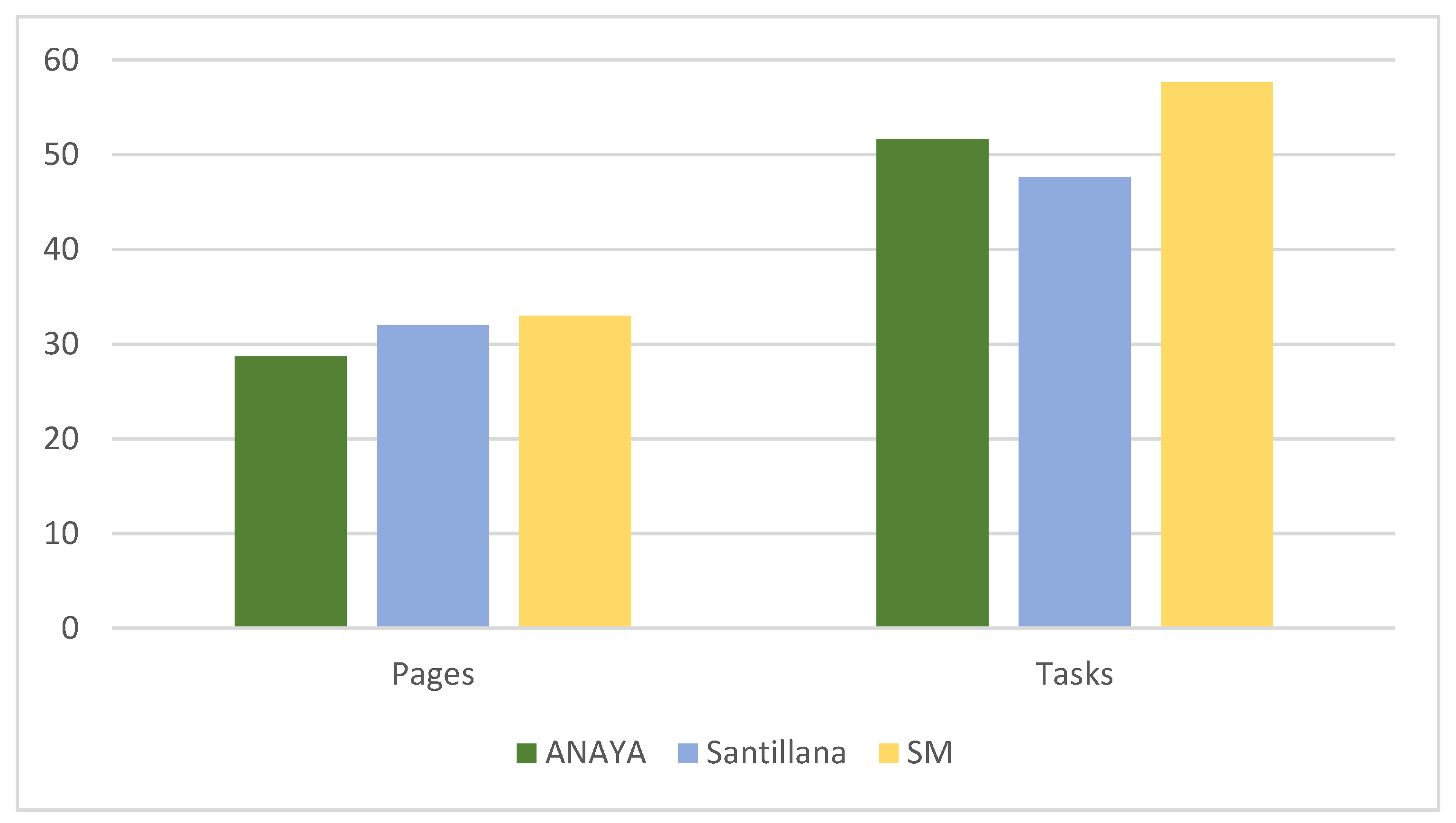
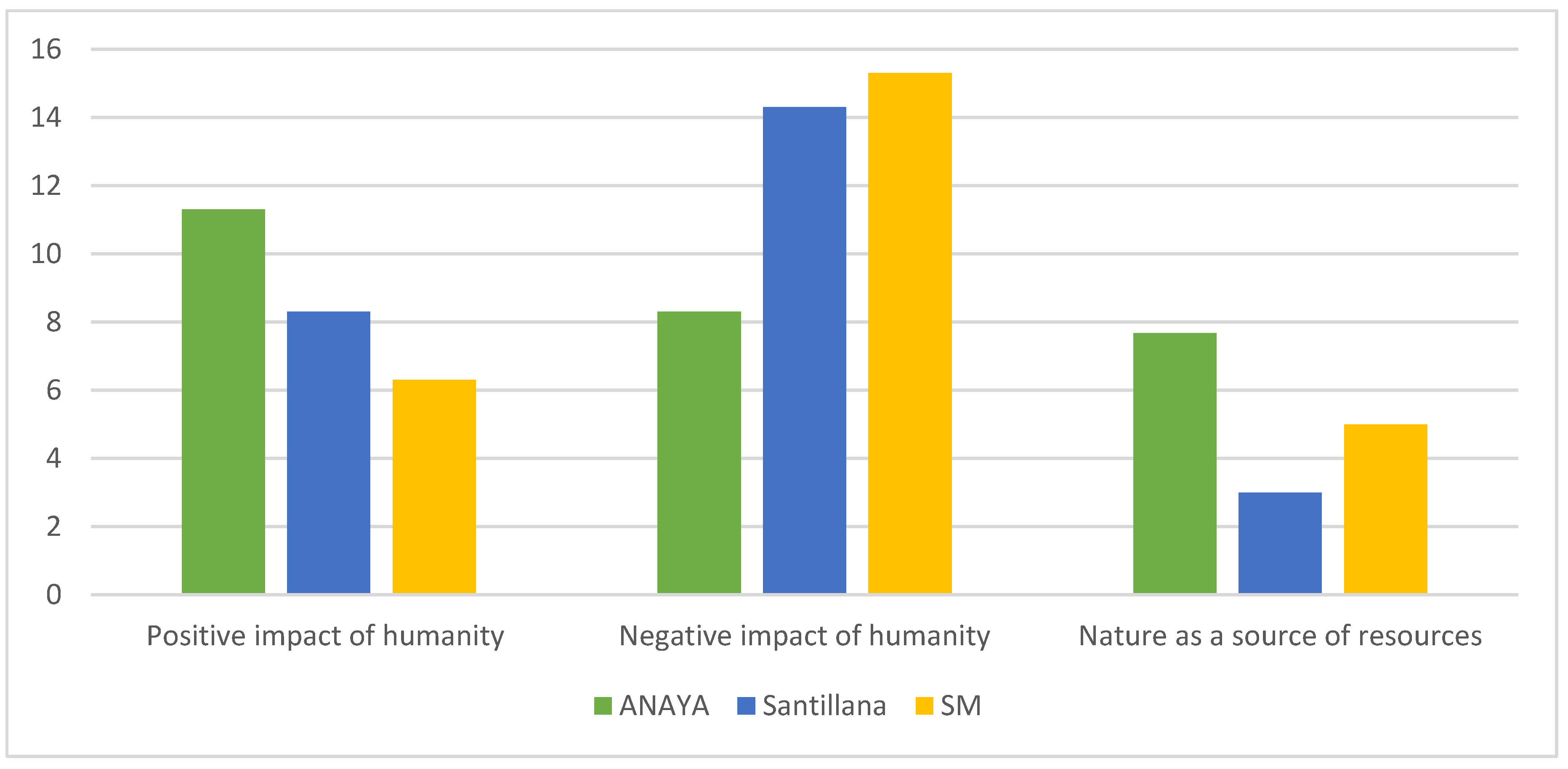
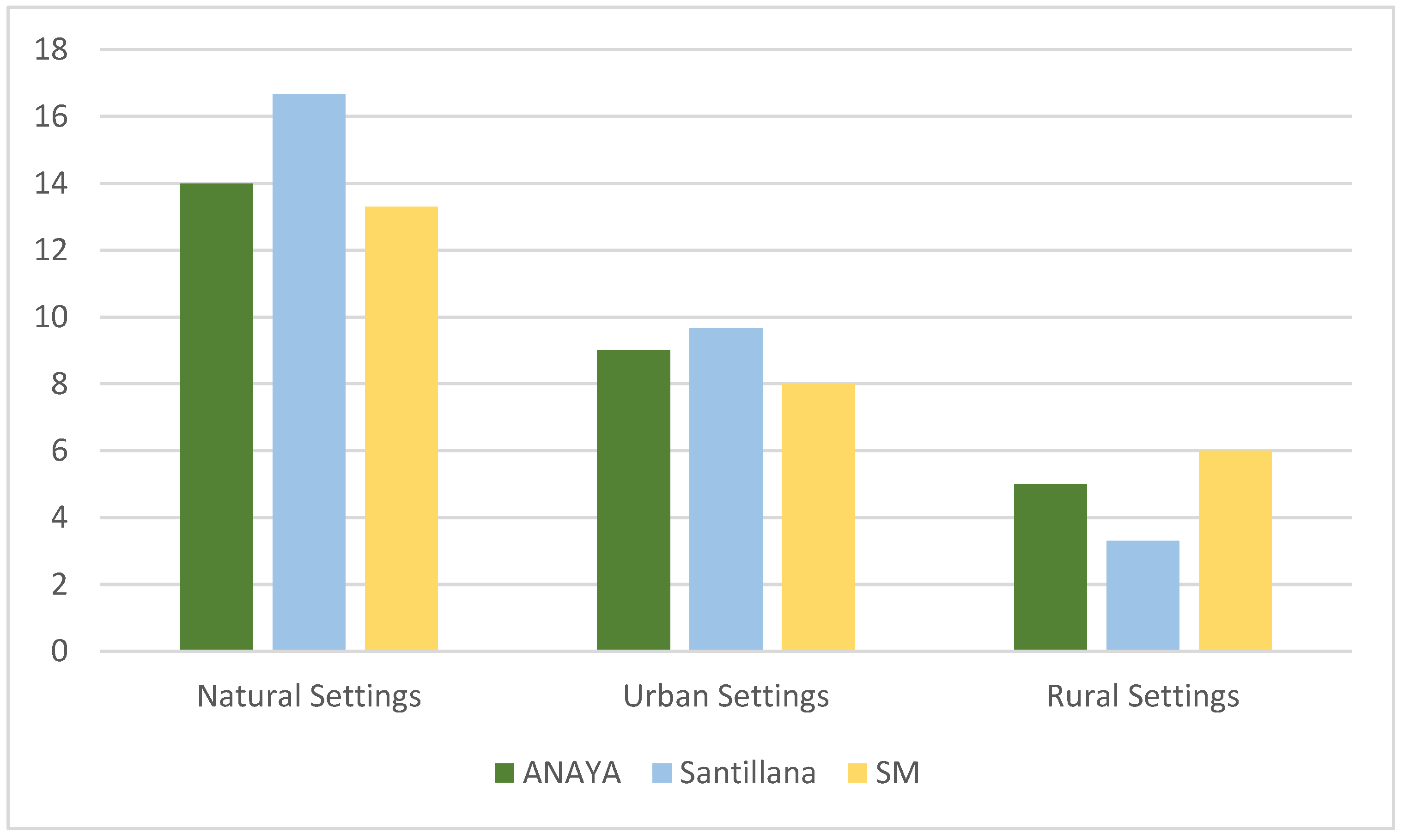
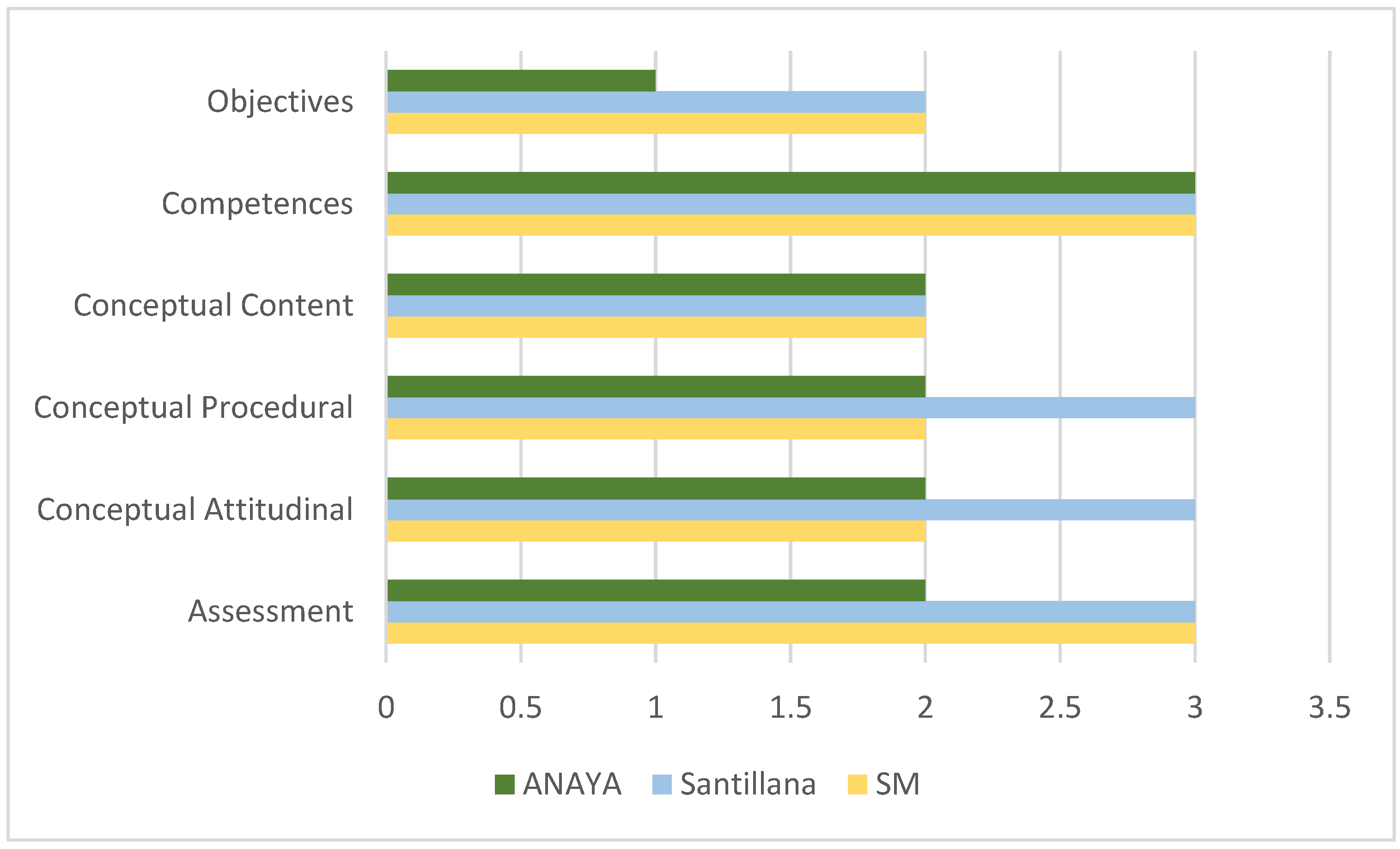
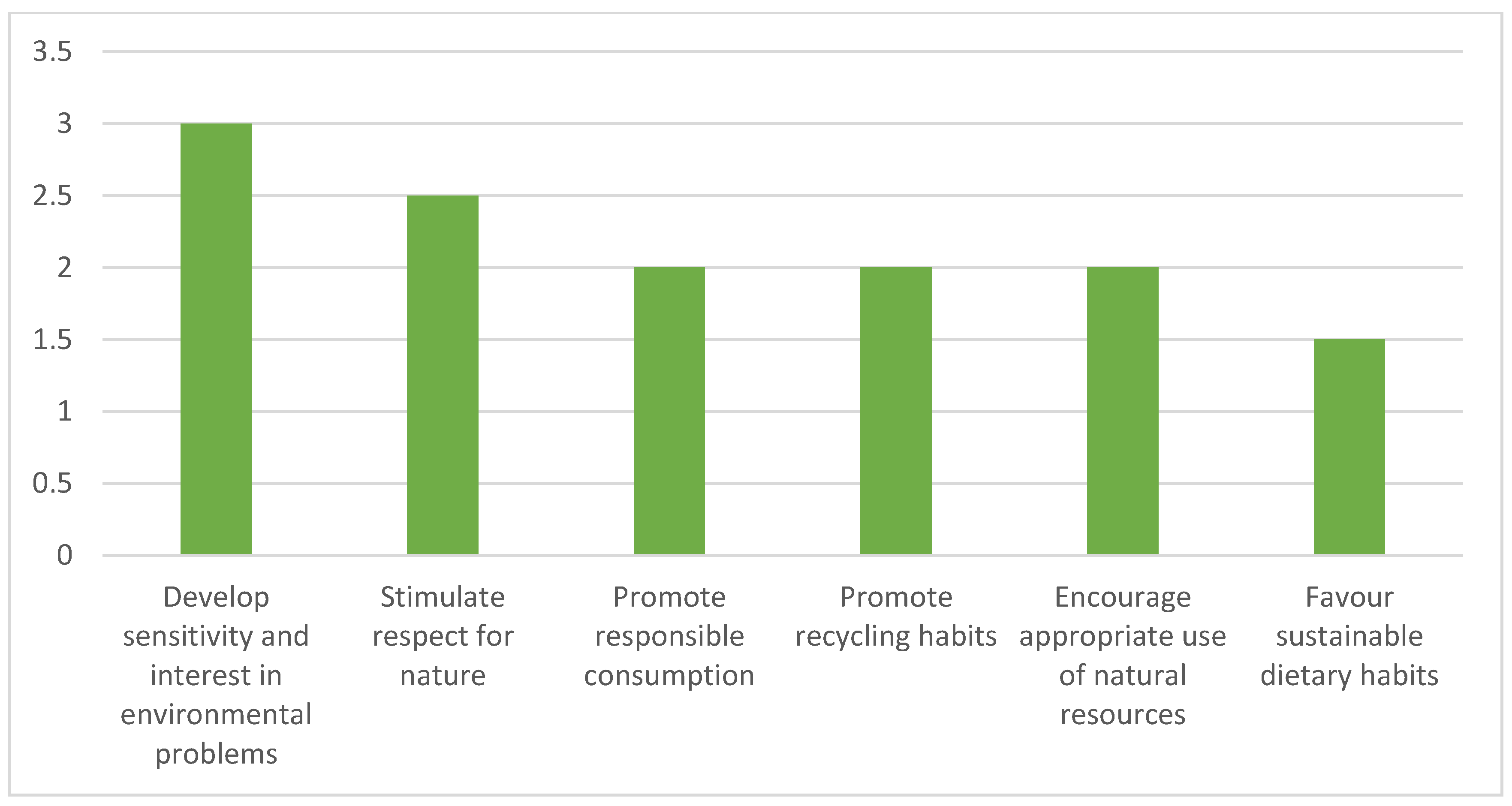
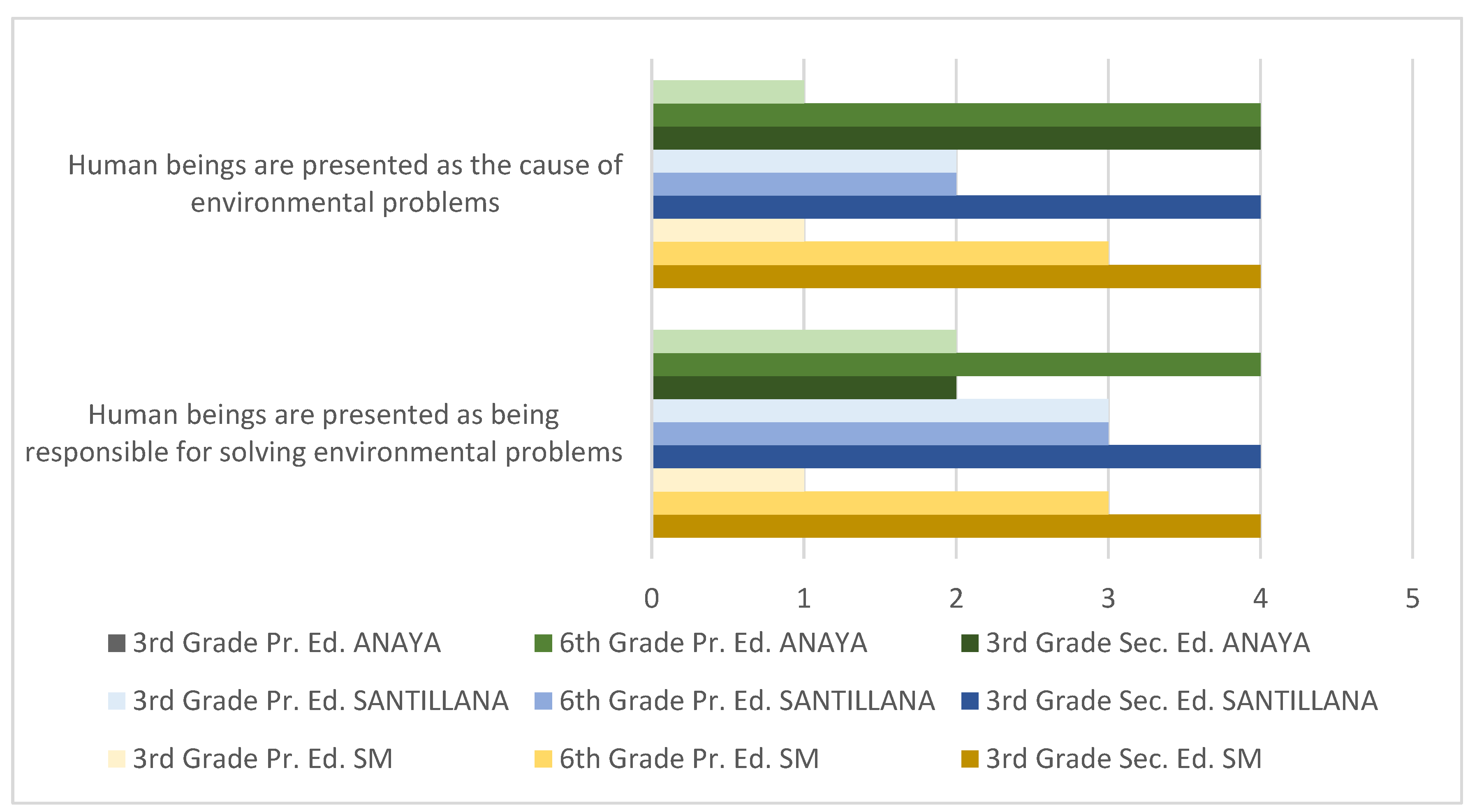
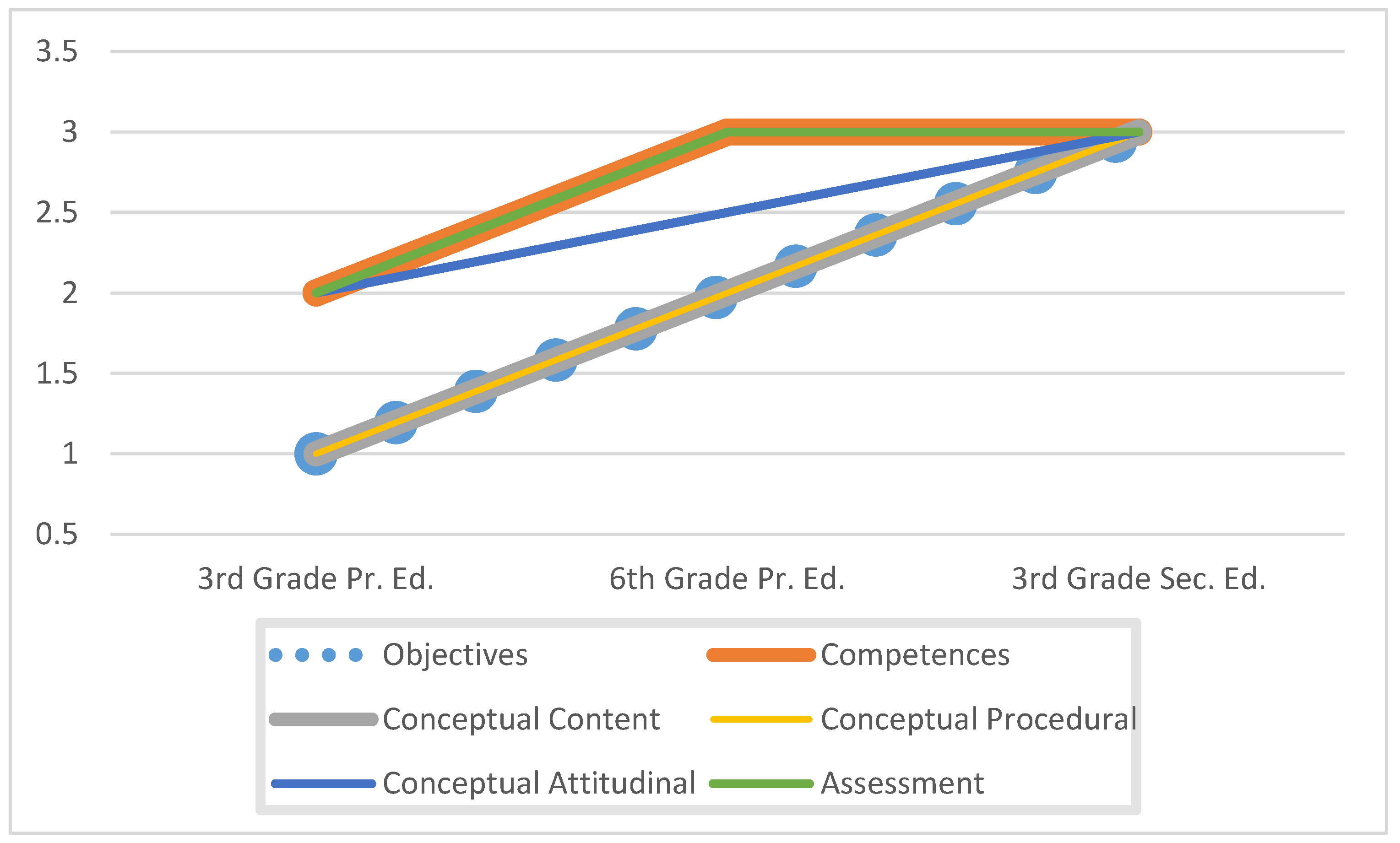
| Anaya 3rd Primary | Santillana 3rd Primary | SM 3rd Primary | Anaya 6th Primary | Santillana 6th Primary | SM 6th Primary | Anaya 3rd Secondary | Santillana 3rd Secondary | SM 3rd Secondary | |
|---|---|---|---|---|---|---|---|---|---|
| Format | |||||||||
| Complete units devoted to environmental education | 0 | 0 | 0 | 1 | 1 | 0 | 0 | 1 | 1 |
| Units that partially include environmental education | 4 | 5 | 2 | 5 | 3 | 6 | 7 | 7 | 8 |
| Pages | 11 | 18 | 17 | 25 | 27 | 31 | 50 | 51 | 51 |
| Diagrams | 0 | 0 | 0 | 2 | 1 | 3 | 9 | 10 | 5 |
| Maps | 0 | 1 | 2 | 1 | 2 | 6 | 17 | 13 | 5 |
| Tables and statistics | 0 | 0 | 0 | 1 | 2 | 0 | 11 | 6 | 1 |
| Tasks | 21 | 26 | 23 | 66 | 64 | 37 | 68 | 53 | 113 |
| Images | |||||||||
| Natural | 10 | 10 | 10 | 19 | 27 | 16 | 13 | 13 | 14 |
| Urban | 9 | 14 | 9 | 8 | 8 | 7 | 10 | 12 | 8 |
| Rural | 0 | 3 | 0 | 3 | 4 | 5 | 12 | 3 | 13 |
| Positive impact of humanity | 7 | 10 | 5 | 14 | 3 | 5 | 13 | 12 | 9 |
| Negative impact of humanity | 3 | 6 | 5 | 7 | 15 | 21 | 15 | 22 | 20 |
| Nature as a source of resources | 1 | 3 | 0 | 1 | 2 | 3 | 21 | 4 | 12 |
| Anaya 3rd Primary | Santillana 3rd Primary | SM 3rd Primary | Anaya 6th Primary | Santillana 6th Primary | SM 6th Primary | Anaya 3rd Secondary | Santillana 3rd Secondary | SM 3rd Secondary | |
|---|---|---|---|---|---|---|---|---|---|
| Objectives | |||||||||
| To generate basic skills in the use of sources of information | 1 | 1 | 2 | 4 | 3 | 3 | 3 | 3 | 3 |
| To develop critical thought | 1 | 1 | 1 | 2 | 2 | 2 | 2 | 2 | 2 |
| To promote entrepreneurial spirit and personal initiative | 1 | 2 | 1 | 2 | 2 | 2 | 1 | 3 | 1 |
| To encourage participation | 1 | 1 | 1 | 1 | 1 | 1 | 1 | 1 | 1 |
| To promote planning and decision-making | 1 | 2 | 2 | 3 | 3 | 3 | 4 | 4 | 2 |
| To encourage the taking of responsibility | 1 | 2 | 1 | 3 | 3 | 2 | 1 | 3 | 1 |
| Competences | |||||||||
| Learning to learn | 2 | 2 | 2 | 3 | 3 | 3 | 3 | 3 | 3 |
| Digital competence | 2 | 2 | 3 | 4 | 3 | 4 | 3 | 4 | 4 |
| Social and civic competences | 3 | 3 | 2 | 3 | 4 | 3 | 1 | 4 | 2 |
| Conceptual content | |||||||||
| General | 0 | 0 | 0 | 3 | 3 | 3 | 2 | 4 | 4 |
| Climate change | 1 | 1 | 1 | 2 | 3 | 4 | 3 | 4 | 4 |
| Environmental degradation | 2 | 2 | 2 | 2 | 2 | 3 | 4 | 3 | 4 |
| Sustainable development | 1 | 1 | 1 | 1 | 3 | 1 | 3 | 2 | 1 |
| Governance | 0 | 0 | 0 | 3 | 3 | 3 | 2 | 4 | 4 |
| Atmosphere | |||||||||
| Greenhouse effect | 0 | 0 | 0 | 3 | 0 | 1 | 4 | 4 | 4 |
| Air pollution | 1 | 1 | 1 | 3 | 2 | 2 | 3 | 4 | 3 |
| Ozone layer | 0 | 0 | 0 | 3 | 0 | 0 | 1 | 3 | 4 |
| Acid rain | 0 | 0 | 0 | 0 | 0 | 0 | 3 | 3 | 4 |
| Lithosphere | |||||||||
| Soil pollution | 0 | 2 | 1 | 3 | 2 | 2 | 1 | 4 | 1 |
| Erosion | 0 | 0 | 0 | 0 | 0 | 1 | 3 | 4 | 1 |
| Hydrosphere | |||||||||
| Overexploitation of groundwater | 0 | 0 | 1 | 1 | 0 | 2 | 3 | 4 | 4 |
| Water pollution | 1 | 1 | 0 | 3 | 2 | 3 | 4 | 4 | 3 |
| Biosphere | |||||||||
| Deforestation | 1 | 3 | 1 | 1 | 3 | 2 | 4 | 4 | 2 |
| Protected areas | 3 | 3 | 4 | 4 | 4 | 4 | 4 | 1 | 2 |
| Desertification | 0 | 0 | 0 | 3 | 0 | 2 | 3 | 3 | 2 |
| Attitudinal | |||||||||
| Encourage appropriate use of natural resources | 2 | 3 | 1 | 3 | 3 | 1 | 2 | 4 | 2 |
| Promote responsible consumption | 2 | 3 | 1 | 4 | 3 | 4 | 1 | 3 | 4 |
| Favor sustainable dietary habits | 0 | 0 | 0 | 1 | 0 | 1 | 0 | 1 | 3 |
| Promote recycling habits | 1 | 3 | 2 | 4 | 2 | 2 | 1 | 3 | 2 |
| Stimulate respect for nature. Develop sensitivity and interest in environmental problems | 2 | 2 | 1 | 2 | 2 | 2 | 2 | 3 | 3 |
| Procedural | |||||||||
| Solving environmental problems | 3 | 3 | 2 | 4 | 4 | 2 | 2 | 4 | 3 |
| Translating and interpreting messages | 0 | 0 | 0 | 1 | 2 | 0 | 2 | 2 | 3 |
| Transforming, creating, or inventing | 3 | 2 | 3 | 3 | 3 | 3 | 3 | 4 | 3 |
| Judging and evaluating | 1 | 2 | 1 | 2 | 2 | 1 | 2 | 3 | 2 |
| Choosing and deciding in different situations | 1 | 2 | 1 | 1 | 3 | 1 | 4 | 4 | 1 |
| Summarizing or generalizing information | 1 | 1 | 1 | 1 | 1 | 1 | 2 | 3 | 3 |
| Communicating experience or results | 1 | 1 | 1 | 2 | 3 | 3 | 2 | 3 | 3 |
| Assessment | |||||||||
| The learning objectives are explained to students | 2 | 3 | 3 | 2 | 3 | 3 | 2 | 4 | 4 |
| Students are encouraged to think about their interests | 1 | 2 | 3 | 2 | 2 | 2 | 2 | 3 | 3 |
| Human beings are presented as the cause of environmental problems | 1 | 2 | 1 | 4 | 2 | 3 | 4 | 4 | 4 |
| Human beings are presented as being responsible for solving environmental problems | 2 | 3 | 1 | 4 | 3 | 3 | 2 | 4 | 4 |
| Predominant level of cognitive demand in exercises | 1 | 2 | 2 | 2 | 2 | 3 | 2 | 3 | 3 |
| The exercises propose discussion and/or allow the students to develop and express their own opinions | 1 | 3 | 2 | 3 | 3 | 3 | 3 | 4 | 4 |
| 3rd Grade Pr. Ed. | 6° Grade Pr. Ed. | 3rd Grade Sec. Ed. | |
|---|---|---|---|
| ANAYA | 11 (143) | 25 (143) | 50 (293) |
| 7.69% | 17.48% | 17.06% | |
| SANTILLANA | 18 (135) | 27 (226) | 51 (335) |
| 13.33% | 11.95% | 15.22% | |
| SM | 17 (142) | 31 (230) | 51 (263) |
| 11.97% | 13.48% | 19.39% |
Publisher’s Note: MDPI stays neutral with regard to jurisdictional claims in published maps and institutional affiliations. |
© 2021 by the authors. Licensee MDPI, Basel, Switzerland. This article is an open access article distributed under the terms and conditions of the Creative Commons Attribution (CC BY) license (http://creativecommons.org/licenses/by/4.0/).
Share and Cite
García-González, J.A.; García Palencia, S.; Sánchez Ondoño, I. Characterization of Environmental Education in Spanish Geography Textbooks. Sustainability 2021, 13, 1159. https://doi.org/10.3390/su13031159
García-González JA, García Palencia S, Sánchez Ondoño I. Characterization of Environmental Education in Spanish Geography Textbooks. Sustainability. 2021; 13(3):1159. https://doi.org/10.3390/su13031159
Chicago/Turabian StyleGarcía-González, Juan Antonio, Saúl García Palencia, and Irene Sánchez Ondoño. 2021. "Characterization of Environmental Education in Spanish Geography Textbooks" Sustainability 13, no. 3: 1159. https://doi.org/10.3390/su13031159
APA StyleGarcía-González, J. A., García Palencia, S., & Sánchez Ondoño, I. (2021). Characterization of Environmental Education in Spanish Geography Textbooks. Sustainability, 13(3), 1159. https://doi.org/10.3390/su13031159






